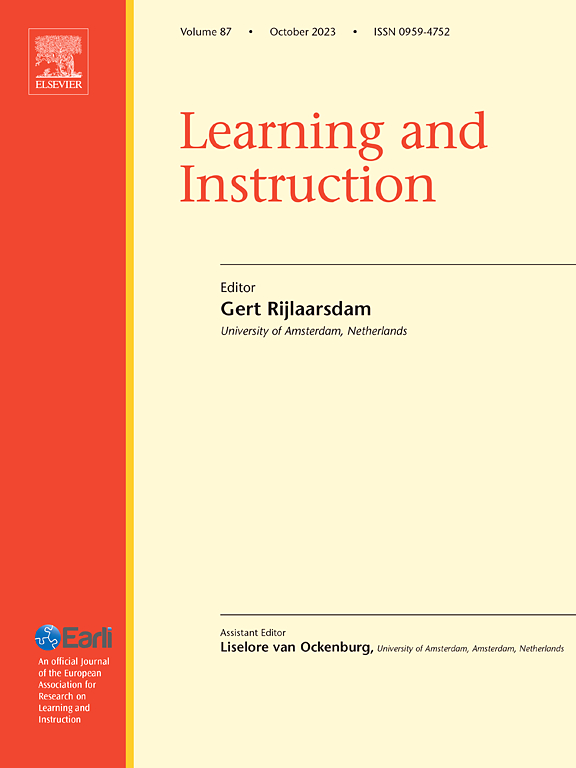揭示城乡差异:中国小学生阅读与写作发展的综合分析
IF 4.9
1区 教育学
Q1 EDUCATION & EDUCATIONAL RESEARCH
引用次数: 0
摘要
阅读和写作是儿童发展的关键技能。然而,在像中国这样具有巨大地理和社会经济多样性的人口众多的国家,很少有人注意比较城乡背景下的扫盲发展轨迹。目的全面评价和揭示我国小学生读写能力发展的城乡差距。样本:来自中国广西壮族自治区河池市益州区和柳州市柳南区的三至六年级学生2625名(农村1080名,城市1545名)。方法采用综合量表,从多个维度评估被试的读写能力发展。城乡差距通过总体表现、技能维度、错误类型、性别和种族因素以及读写障碍风险来衡量。结果城市学生的整体读写能力明显优于农村学生,特别是在高水平任务中。这种差距随着年龄的增长而扩大,农村六年级学生比城市学生至少落后两个年级。少数民族身份表现出明显的城乡差异,对农村学生的成绩有显著影响,而对城市学生没有显著影响。采用统一的划分标准,发现农村地区(19.2%)的读写障碍高危儿童比例高于城市地区(2.8%)。即使有单独的下限,农村的比率(8.9%)仍然高于城市的比率(8%)。高风险的农村学生面临着更持久的挑战,特别是在高年级,这表明他们更容易受到持续的读写困难的影响。结论本研究揭示了中国小学生读写能力发展的显著城乡差异,为提高中国儿童读写能力教育质量提供了有针对性的政策和干预措施。本文章由计算机程序翻译,如有差异,请以英文原文为准。
Unveiling the urban-rural discrepancy: A comprehensive analysis of reading and writing development among Chinese elementary school students
Background
Reading and writing are critical skills for children's development. However, little attention has been given to comparing literacy development trajectories between rural-urban settings in populous countries with vast geographical and socio-economic diversity like China.
Aim
To comprehensively assess and unveil the urban-rural gap of literacy development in Chinese elementary students.
Sample
2625 students (1080 rural and 1545 urban) across grades 3 to 6 from Yizhou District, Hechi City and Liunan District, Liuzhou City, both located in Guangxi Zhuang Autonomous Region, China.
Methods
A comprehensive scale evaluated participants’ literacy development across multiple dimensions. Urban-rural gaps were measured by overall performance, skill dimensions, error types, gender and ethnicity factors, and risk of literacy disorder.
Results
Urban students significantly outperformed rural students in overall literacy skills, especially in higher-level tasks. This gap widened with age, with rural sixth-graders lagging behind urban peers by at least two grades. Ethnic minority status showed a pronounced urban-rural disparity, significantly impacting rural students’ performance but not urban students. A higher proportion of high-risk children for literacy disorders was identified in rural areas (19.2 %) compared to urban areas (2.8 %) using a unified cutoff. Even with separate cutoffs, the rural rate (8.9 %) remained higher than the urban rate (8 %). High-risk rural students faced more enduring challenges, especially in higher grades, suggesting greater vulnerability to persistent literacy difficulties.
Conclusions
This large-scale study reveals significant urban-rural disparities in Chinese elementary students’ literacy development which highlights targeted policy and interventions for promoting literacy education quality for Chinese children.
求助全文
通过发布文献求助,成功后即可免费获取论文全文。
去求助
来源期刊

Learning and Instruction
Multiple-
CiteScore
11.30
自引率
4.80%
发文量
109
期刊介绍:
As an international, multi-disciplinary, peer-refereed journal, Learning and Instruction provides a platform for the publication of the most advanced scientific research in the areas of learning, development, instruction and teaching. The journal welcomes original empirical investigations. The papers may represent a variety of theoretical perspectives and different methodological approaches. They may refer to any age level, from infants to adults and to a diversity of learning and instructional settings, from laboratory experiments to field studies. The major criteria in the review and the selection process concern the significance of the contribution to the area of learning and instruction, and the rigor of the study.
 求助内容:
求助内容: 应助结果提醒方式:
应助结果提醒方式:


